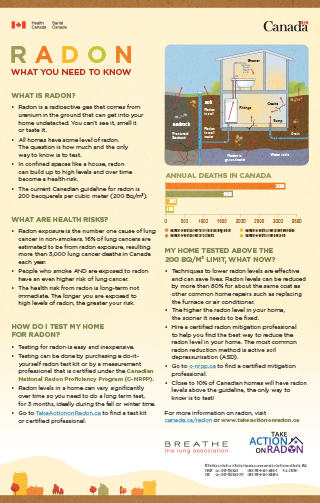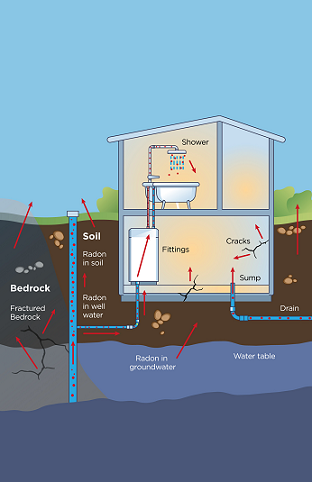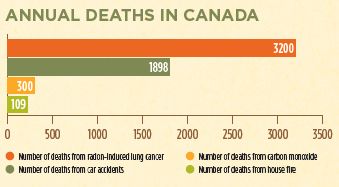Radon - What you need to know

Download the alternative format
(PDF format, 2.6 MB, 1 page)
Order a copy
2025
Cat.: H129-75/2025E-PDF
ISBN: 978-0-660-77755-9
Pub.: 250117
Organization: Health Canada
What is radon?
- Radon is a radioactive gas that comes from uranium in the ground that can get into your home undetected. You can’t see it, smell it or taste it.
- All homes have some level of radon. The question is how much and the only way to know is to test.
- In confined spaces like a house, radon can build up to high levels and over time become a health risk.
- The current Canadian guideline for radon is 200 becquerels per cubic meter (200 Bq/m3).
Figure 1. How can radon get into my home?

Figure 1 - Text Description
This diagram illustrates the radon movements inside and outside. Radon, in the gaseous state, moves freely through the ground, allowing it to be released into the atmosphere or to infiltrate buildings. When radon is released from the bedrock into the outside air, it is diluted to concentrations too low to be of concern. However, if a building has been constructed on bedrock or uranium-containing soil, radon gas can enter the building through cracks in foundation walls and floor slabs, construction joints, openings around water connections and support poles, floor drains and sumps, empty spaces in walls and the water supply network. When radon is contained in closed or poorly ventilated areas, it can accumulate in high concentrations. Radon levels are generally highest in basements and crawl spaces, since these are the closest to the source and the least well ventilated.
What are health risks?
- Radon exposure is the number one cause of lung cancer in non-smokers. 16% of lung cancers are estimated to be from radon exposure, resulting more than 3,000 lung cancer deaths in Canada each year.
- People who smoke and are exposed to radon have an even higher risk of lung cancer.
- The health risk from radon is long-term not immediate. The longer you are exposed to high levels of radon, the greater your risk.
How do I test my home for radon?
- Testing for radon is easy and inexpensive.
- Testing can be done by purchasing a do-it-yourself radon test kit or by a measurement professional that is certified under the Canadian National Radon Proficiency Program (C-NRPP).
- Radon levels in a home can vary significantly over time so you need to do a long term test, for 3 months, ideally during the fall or winter time.
- Go to TakeActiononRadon.ca to find a test kit or certified professional.
Figure 2. Annual Deaths in Canada

Figure 2 - Text Description
The bar chart illustrates how radon-induced lung cancer compares to other health concerns. The annual death rate in Canada from exposure to radon-induced lung cancer is 3,200 deaths, higher than car accidents 1,898 deaths, carbon monoxide 300 deaths and house fires 109 deaths combined.
My home tested above the 200 Bq/M3 limit, what now?
- Techniques to lower radon levels are effective and can save lives. Radon levels can be reduced by more than 80% for about the same cost as other common home repairs such as replacing the furnace or air conditioner.
- The higher the radon level in your home, the sooner it needs to be fixed.
- Hire a certified radon mitigation professional to help you find the best way to reduce the radon level in your home. The most common radon reduction method is active soil depressurisation (ASD).
- Go to c-nrpp.ca to find a certified mitigation professional.
- 1 in 5 homes in Canada have high radon levels. The only way to know your level is to test.
For more information on radon, visit canada.ca/radon or www.takeactiononradon.ca
© His Majesty the King in Right of Canada, represented by the Minister of Health, 2025
Print Cat.: H129-75/2025E
PDF Cat.: H129-75/2025E-PDF
ISBN: 978-0-660-77757-3
ISBN: 978-0-660-77755-9
Pub.: 250117